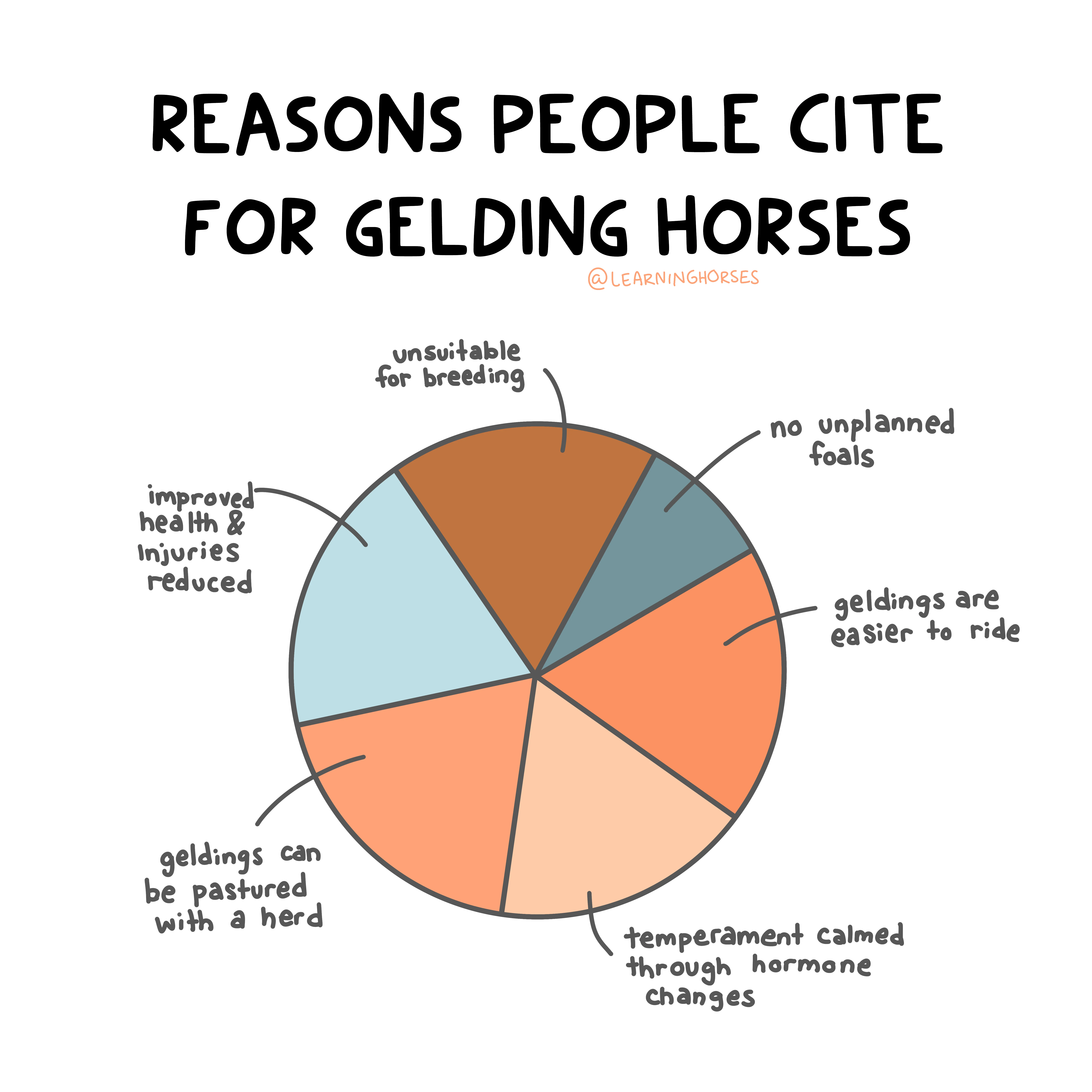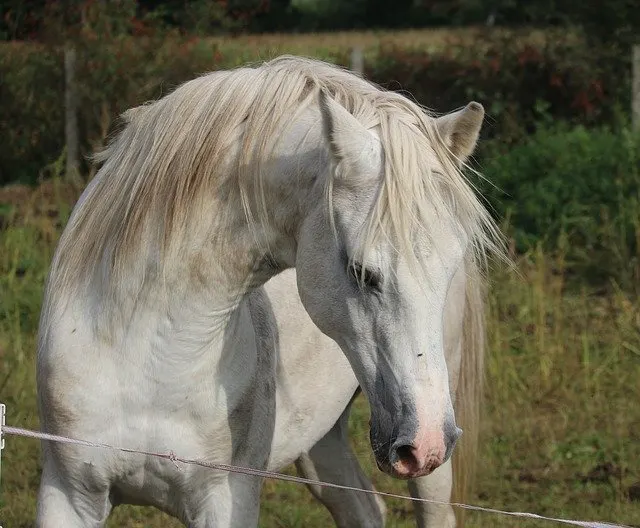A gelding is a male horse that has had a procedure similar to neutering a male dog. When a horse has “been gelded” it means that they’ve had the equine equivalent of the neutering procedure performed routinely on dogs and cats.
A gelding horse is much calmer and easier to train than an ungelded stallion. While a stallion’s hormones can make them difficult to manage, geldings often make excellent first horses and kids’ horses.
One frequent question horse owners are asked by non-riders is “What is a gelding?” In this article, you’ll get a complete answer. Let’s start with a simple chart:

| Stallion | Gelding | |
|---|---|---|
| Reproduction | Capable of breeding and producing foals | Sterile, unable to reproduce |
| Behavior | May be aggressive | Generally more calm |
| Training | Requires experienced handlers | Easier to train and handle |
| Purpose | Used for breeding foals or horse shows | Suitable for pleasure riding and competion |
Colt, Stallion, or Gelding: Changing Terms through a Lifespan
The answer to what is a gelding horse can change slightly according to a horse’s age and status. Knowing some terms can be helpful:
- A Colt is a young male horse, usually under 2 years old
- A Stallion is a sexually mature male horse
- A gelding is an adult horse that’s been sterilized through a surgical procedure.
- Statistically, most male horses become geldings between the ages of 1 and 2 years old.12
Most horse owners decide when their horse is a colt whether or not they will allow the colt to grow into a stallion or geld the horse as it enters maturity. Many casual breeders decide in advance to geld a horse, but experienced breeders who breed for show, performance (like racing), or to preserve a rare breed of horse may watch the colt grow before deciding. Colts who have excellent confirmation, temperament, and performance make the best candidates to not be gelded.
Gelding for Confirmation
Some researchers and authors have stated that the timing of the gelding procedure can cause a gelding to have different confirmation.
- Gelding later may cause a horse to be more muscular, with a thicker neck iconic of many stallions.
- Other authors assert that horses that are castrated before maturity may grow taller than those that are gelded after maturing.2
Some people choose when to geld a colt based on how they want the horse to grow. Theories conflict, however, on how gelding affects the maturing horse.
Some believe that, by definition, gelding a horse before sexual maturity redirects growth energy towards growing in height, while others insist that the hormonal changes experienced by stud-colts as they mature into adult stallions create better, more defined muscle tone and better-developed muscles at the crest of the neck.
Only horses that are healthy, trainable, and well-conformed should be allowed to remain stallions. This is especially true since stallions are more difficult to handle, house, and care for. Read more about evaluating colts for stud horse candidates.

Stallions tend to develop thicker necks- a trait some find desirable
To Geld or Not to Geld: Choosing for your Colt
Geldings are docile and easy to train, but there are good reasons to leave a horse a stallion. Here’s a basic rundown:
Reasons to Geld
Geldings are popular as horses for riders who enjoy riding for pleasure or trail riding. Geldings also are preferred as amateur show horses.
- 🚫 No unplanned pregnancies: Geldings cannot impregnate mares, so if you also have a female horse, you won’t have to worry about unexpected surprises!
- 🧘♂️ Calmer temperament: Geldings tend to be more relaxed. Because they have less androgens in their system, they’re less likely to have hormone-based behaviors. 2
- 🏇 More Fun to Ride: Geldings are often easier to handle and train for various equestrian activities. Additionally, you can ride geldings around a mare in heat without either horse having strong hormonal reactions.
- 🚫 Reduced risk of injury: Without stallion instincts, geldings are less likely to engage in dangerous behaviors like charging fences or kicking stall panels in an effort to reach a mare in heat.
- 🤝 Social Herd Life: Geldings have an easier life than stallions: Rather than living separated or (in a communal herd-type housing) having to fight for status, geldings simply get along with other horses.
- 🩺 Health benefits: Castration can reduce the risk of certain health issues, such as testicular cancer.
Reasons Not to Geld
Male horses resulting from breeding programs intended to produce racehorses or elite show horses are far less likely to undergo the gelding procedure.
- ❌ No breeding potential: Geldings cannot be used for breeding, limiting their contribution to the equine gene pool.
- 🔄 Irreversible procedure: The castration that is key to what a gelding is, is a permanent decision that cannot be reversed.
- 💉 Surgical risks: As with any surgery, there is a small risk of complications during the castration procedure.
- 🌟 Potential loss of performance edge: In certain disciplines, some stallions may exhibit competitive advantages.
- 🤔 No Stud Fee Income: High-quality stallions, and stud fees, can be a way that horse farms make money.
Geldings vs Stallions vs Mares: According to Research
A 2020 study looked at data from a questionnaire about horse behavior filled out by 1233 horse owners. The researchers found that mares were more likely to move away when being caught compared to geldings, while geldings were more likely to chew on lead ropes and rugs. However, when it came to ridden behavior, there were no significant differences between mares and geldings.3
The Gelding Operation
Technically, gelding surgery is the surgical removal of a horse’s testicles. The veterinary procedure of gelding a stallion is a moderately invasive procedure that is usually done under general anesthesia but can be done on a “farm call” by a vet who comes to the farm. You can read more about the procedure direct from the American Association of Equine Practitioners.
The gelding operation is a very common procedure but can have elevated risks if the horse has matured into an adult stallion. Complications such as colic, herniation, infection, or reactions to the anesthesia can occasionally make the operation fatal.

The Female Horse Equivalent of Gelding
When a female horse is sterilized, it’s referred to by the same name used for dogs and cats: Spaying.
However, spaying isn’t very common.
Unlike gelding a horse, it is actually very dangerous for female horses to be spayed.
Horses are very large animals. Because their health depends on their ability to move, stand, and walk, horses have relatively low rates of veterinary surgery survival compared to other mammals.
While the gelding surgery can be done under light anesthesia on a farm call, often with the horse standing the whole time- a mare’s spay surgery is more complex.
When a mare is spayed, the mare must be put under deep anesthesia in a special veterinary clinic with an operating room designed for large animals. When vets spay a mare, the entire uterus is removed and the operation is (as it is for female humans) a very invasive surgery. Spaying a mare is more expensive and has a longer recovery time than gelding.

Why Female Horses are Spayed
Spaying female horses is possible but the practice is very uncommon.
Female horse spaying is a surgery that is usually only performed when the mare has experienced life-threatening reproductive health issues. Occasionally, it’s for behavior management. This is required when a mare has hormonal cycles that make her difficult to ride or handle (for example, causing riders to fall off when ridden while in heat or biting people).
The longer recovery time results in a much higher cost for spaying mares than for gelding male horses, and this expense contributes to the rarity of spayed female horses.
Typical Gelding Temperament
Although mares have their die-hard fans, and white mares in particular have a solid fanbase for their unique appearance, many riders prefer geldings. Research has determined that there is little if any consistent difference in the temperament of geldings vs mares, but rumors persist. Modern folklore about geldings a 2018 study in the Czech Republic found through a survey of 1,233 mostly-female and mostly-very experienced riders that beliefs about gelding temperament persist, stating:
In a survey where people had to choose between positive or negative words to describe horse temperament, more people picked positive words for male horses. They used words like calm, trainable, reliable, and predictable. When it came to different horse activities like show-jumping, dressage, and trail-riding, most people preferred male horses for trail-riding. Female horses were liked the least for dressage and show-jumping.
https://doi.org/10.1371/journal.pone.0216699
This conflict in the research on horse genders including mares, geldings, and stallions tells us that riders generally prefer geldings- and trust geldings to be calmer, more predictable, and less temperamental than their female counterparts. Researchers concluded that this bias could have an impact on horse well-being and welfare- since “unchosen” mares might be more likely to be abused or neglected due to their lower perceived value.
Key Points:
A gelding is a neutered male horse that is generally calmer and easier to train than stallions. They are preferred for pleasure riding and as first horses.
Geldings eliminate the risk of unplanned pregnancies and have a reduced likelihood of hormone-related behaviors.
However, they cannot be used for breeding, and there is a small risk associated with the surgical procedure. While there may be behavioral differences between mares and geldings in non-ridden situations, there are no significant differences when it comes to ridden behavior.
- Large Animal Medicine for Veterinary Technicians. (2021). United States: Wiley. [↩]
- Varner, D. D., Brinsko, S. P., Schumacher, J., Love, C. C., Blanchard, T. L. (2010). Manual of Equine Reproduction. United Kingdom: Elsevier Health Sciences. [↩] [↩] [↩]
- Aune, A., Fenner, K., Wilson, B., Cameron, E., McLean, A., & McGreevy, P. (2020). Reported behavioural differences between geldings and mares challenge sex-driven stereotypes in ridden equine behaviour. Animals, 10(3), 414. [↩]

